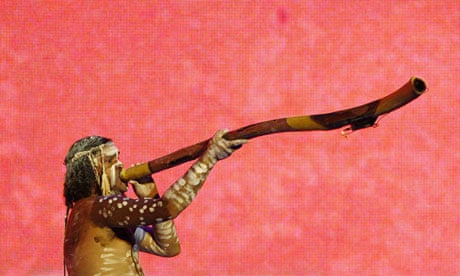What is it? Probably the oldest wind instrument in the world, an unfairly maligned totem of crusty cultural tourism, and a very powerful symbol of Aboriginal dreamtime – the improper use of the instrument ("didgeridoo" is a non-Aboriginal name) outside of traditional ceremonies is still considered offensive by some Aboriginal people.
Who uses it? In modern Western music the didgeridoo still tends to turn up in a lot of crap psytrance and new age symphonies of the Yanni ilk. In Australia, native didgeridoo legends such as Darryl Digarrnga, Jeremy Donovan, Mark Atkins, William Barton, Adrian Burragubba, Alan Dargin and David Blanasi still command respect, though, and each of these men has contributed in their own way to promoting and defending Aboriginal culture – whether it be through political activism (Burragubba), collaborating with the world's leading symphony orchestras (Barton), or trannying-up in Priscilla, Queen of the Desert (Dargin).
How does it work? Famously, the tricky concept of "circular breathing" is key. The player must breathe in through their noise while expelling air through their mouth – if you're good at this then, in theory you should be able to sustain a didg-drone indefinitely. Most people, however, are not good at this. If you're interested, check out these very funny tutorials with a fart-faced man teaching you how to drone, use your voice and build rhythm.
Where does it come from? No one knows exactly where the didgeridoo came from or when it came into use, but it is thought to have been used ceremonially by the Northern Territory tribe of the Kakadu region for at least 1,500 years.
Why is it classic? Those tones. A pulsating drone that is hypnotic and sounds like its being sucked out of the ground itself. Like the best religious music, it is also ominous. A lot of the unusual screeching tones in didgeridoo-playing are intentional echoes of dingo or kookabura calls, too.
What's the best ever didgeridoo song? In recorded Aboriginal music, Mark Atkins's 50-minute continuous drone, Didgeridoo Concerto, is pretty impressive. In Western music? Let's go for Aphex Twin's banging Didgeridoo EP.
Five facts and things The dots and lines that decorate some non-Aboriginal didgeridoos are not recognised by the native Australian community, as the markings on aboriginal didgeridoos relate to very specific aspects of that tribe and region's own dreamtime mythology.
The name didgeridoo itself has no clear etymology, although its assumed to be a conflation of old Irish words for "trumpeter" and jumbled onomatopoeia. The aboriginal name for the instrument varies from tribe to tribe – ngarrriralkpwina, garnbak and bambu are some examples.
The tribal laws governing the correct use of didgeridoo tend to vary drastically in interpretation and fundamentalism. Generally, though, the idea that women are forbidden from playing didgeridoo is a myth (although it is true that their playing is restricted to non-ceremonial, recreational play – which is tolerated, rather than encouraged). Some message board posters came down hard on Alan Dargin for playing the instrument when drunk – apparently a transgression.
Is your other half a snorer? Get them a didgeridoo. A 2005 study in the British Medical Journal found that playing the didgeridoo helped reduce snoring and sleep apnoea. It's the circular breathing that strengthens the airway muscles, apparently.
The didgeridoo equivalent of a Stradivarius would be a didgeridoo crafted by David Blanasi, the didgeridoo master who became the instrument's first superstar as a regular on the Rolf Harris Show in the 1960's. Blanasi disappeared in 2001, amid tantalising rumours of "magical" happenings, with spiritualists claiming to be in contact with him.
